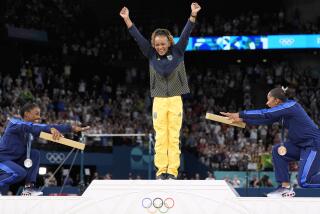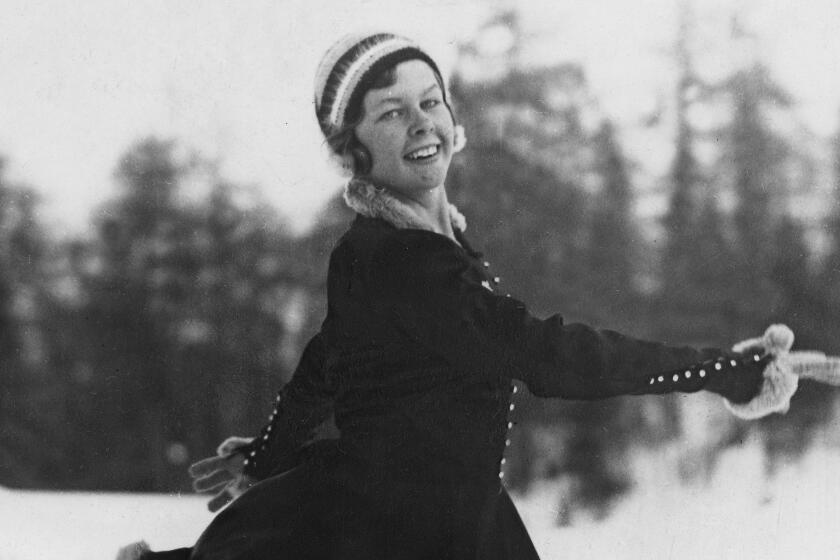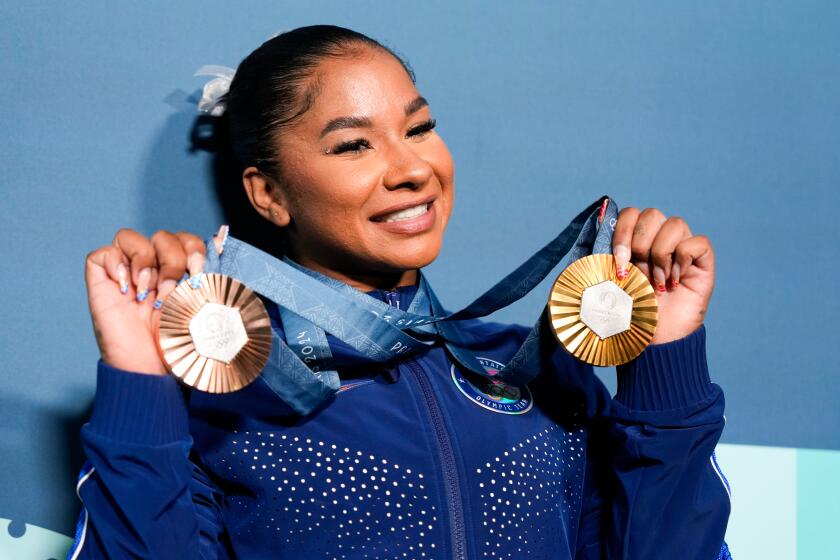Dilemma for the Sport Isn’t Merely Skin Deep
We have come in recent years to expect female pole vaulters to provide compelling drama at international track and field meets. Sunday in Carson, the vaulters also will be engaged, whether they are aware of it or not, in a sociological ramming of the heads that goes to the core of issues confronting their sport and women’s sports in general.
It is between the ones who have chosen to grin and bare it and the one who merely grins.
At issue is the Vaultgirls calendar. Four women in Sunday’s field in the Home Depot Track and Field Invitational, the inaugural event of the Home Depot Center, are among six U.S. pole vaulters who posed in various states of undress for a 2004 calendar. Most notable among the missing bodies is Stacy Dragila, the two-time world champion and 2000 Olympic gold medalist.
The Vaultgirls asked Dragila to pose, but she declined.
Dragila, in a telephone interview this week, was critical of the project, but emphasized that she was not passing moral judgment. That, she acknowledged, would be hypocritical, considering that she was one of the more provocative poseurs for the “2000 Calendar of Champions,” which became better known as Trackgirls.
“I made a mistake,” she said. “I’m a married woman. My body is something that should be between my husband and me, and, by posing like that, I discredited him. It’s not something either of us was comfortable with.”
Beyond that, she said, she discredited herself as an athlete and, ultimately, cheapened the sport and women’s role in it.
*
There are varying opinions. Although the sponsor of Sunday’s meet, Home Depot, deemed the calendar inappropriate for sale inside the stadium, it was endorsed by USA Track & Field and, vaultgirl Mel Mueller said, “mom-approved.”
Mueller, a 2000 Olympian, said that the Trackgirls calendar was the inspiration for this one. The previous one was more artistic, baring the soul as much as it did the body, but Mueller said both serve the same high-minded purpose, to destroy the myth that athletic bodies can’t be feminine.
But, she added, it also would be nice if the calendar enabled the women to raise money for training and drew attention to themselves, their event and their sport.
If the Vaultgirls’ experience is the same as the Trackgirls’, Dragila said, the calendar will not make much money but will attract attention, although not necessarily the kind that the women or the sport need.
“There were some people asking for autographs who hadn’t been around before,” she said, “and from the things they were saying about my body, it was weird.”
Thus the question facing women’s sports: Is it necessary for female athletes to display their femininity in order to sell their sports and, if so, how much should they display?
In a state-of-the-game address last year, LPGA Commissioner Ty Votaw encouraged players to become more fan friendly, which was widely interpreted as, they should smile and show more skin.
A year later, Annika Sorenstam received more attention than any other female golfer in history while dressing about as sexily as Andy Bean.
Dragila, who has gained notice for her body and her performances, now believes the latter is the correct approach for female athletes.
“The calendar wasn’t right for me because it was perceived differently from what I was trying to do on the track,” she said. “I’m not a model; I’m an athlete. Basically, I want to be known for how high I can jump.”
*
In track and field, the struggle for attention is not limited to women. The sport, for more than two decades, has been close to flat-lining in this country. There have been notable blips -- two Summer Olympic Games on home soil and the occasional spectacle, such as the Michael Johnson-Maurice Greene 200-meter duel in Sacramento and ... I can’t think of another.
Most of the best athletes have gone to other sports, taking fans, sponsors and media with them. Potential new fans among the young who might in the past have been intrigued by seeing who could run faster, jump higher or throw farther have turned instead to skateboarding. Promoters have lost money. Meets have faded away.
So Rich Perelman, the Home Depot meet director, is unapologetic about the entry of the Unknown Shotputter -- “competes in mask!” according to the heat sheet -- in Sunday’s competition.
It is bound to be controversial. Emanuel Hudson, manager of the HSI club that includes Greene and Ato Boldon, called it “an unfortunate sideshow.”
“The day you have an athlete in a mask is a sad day for track and field,” Hudson said.
But Perelman said that Un, as he calls him for short, is a creditable shotputter who has a best this year of 67 feet 5 1/2 inches, ranking him fourth in a good field that includes Kevin Toth, the event’s world leader, and John Godina, three-time world champion.
“The guy wants to compete, win a little money and have a good time,” Perelman said. “I’m all for that.”
If it also sells tickets or entertains the fans enough so that they buy tickets again next year, all the better.
On that, Dragila and Mueller agreed.
“Kids are going to think he’s a superhero,” Dragila said. “It might help create a new generation of track fans.”
Maybe Un will begin a track and field renaissance, make it possible for women in the sport to gain attention without having to take their clothes off. If so, fans in Carson on Sunday might someday be asking, “Who was that masked man?”
Randy Harvey can be reached at [email protected].
More to Read
Go beyond the scoreboard
Get the latest on L.A.'s teams in the daily Sports Report newsletter.
You may occasionally receive promotional content from the Los Angeles Times.








